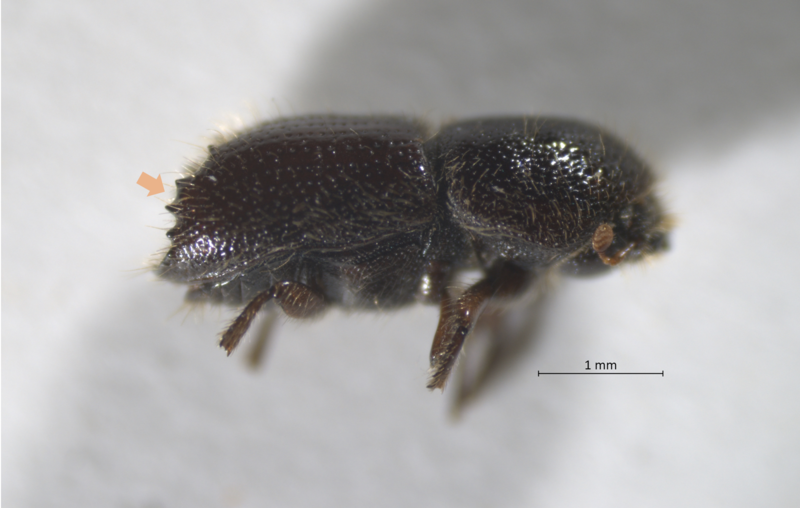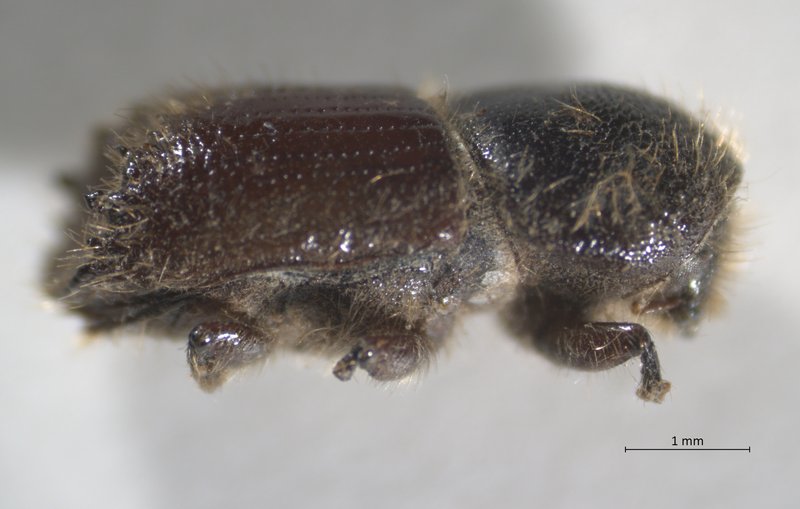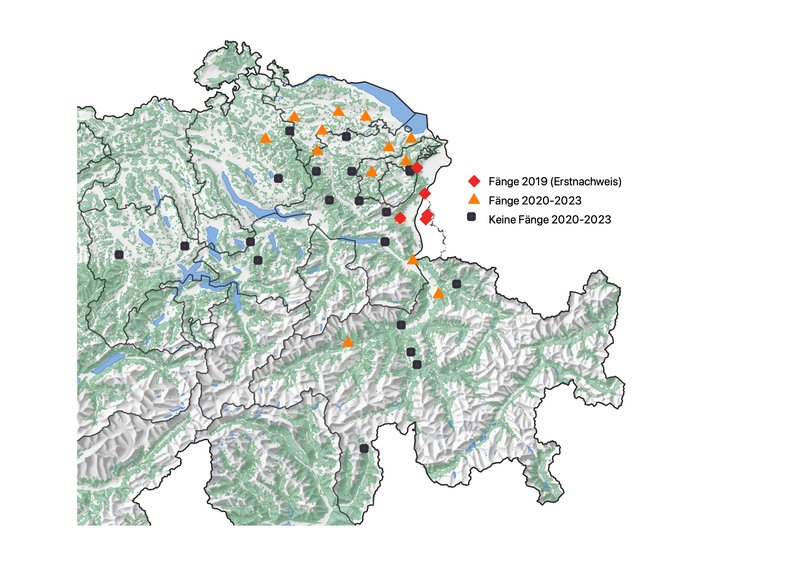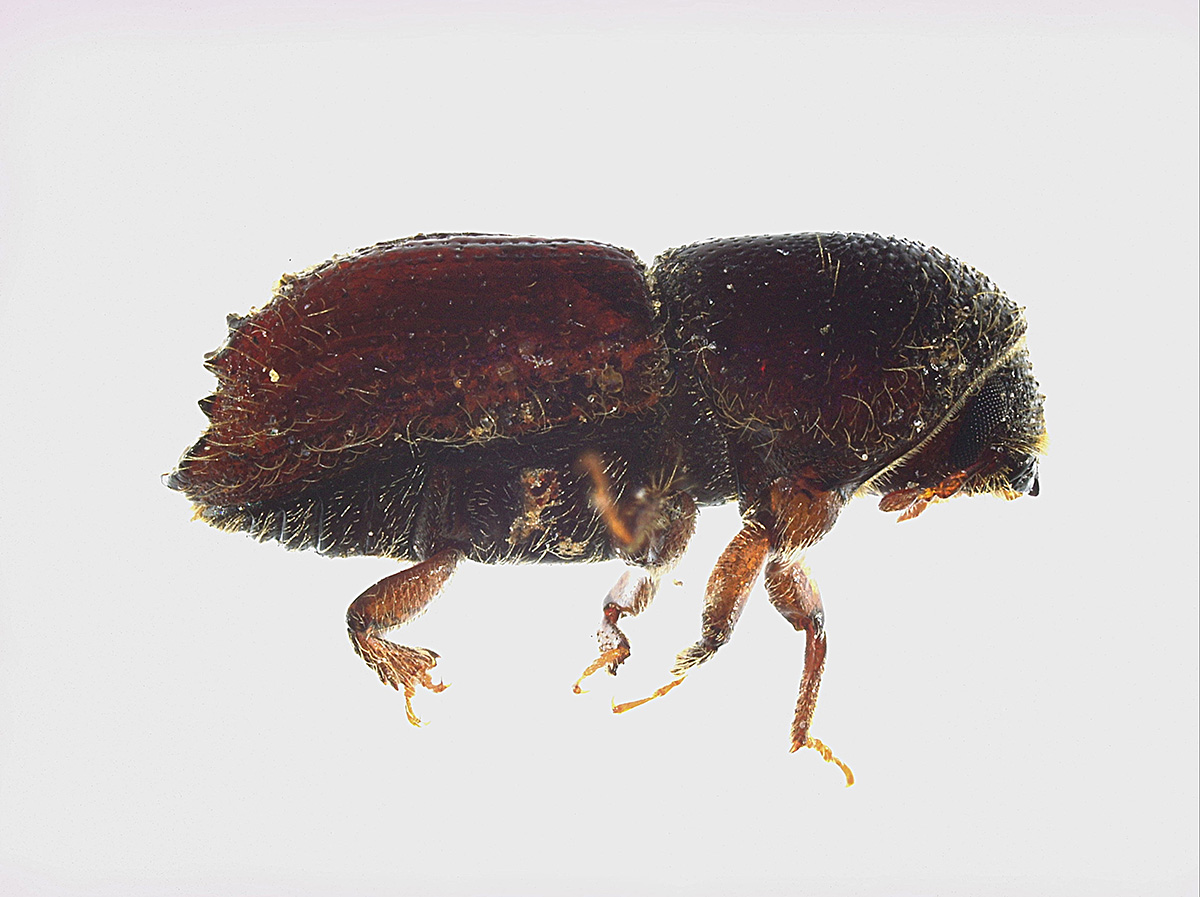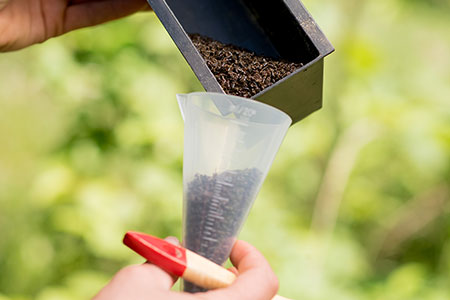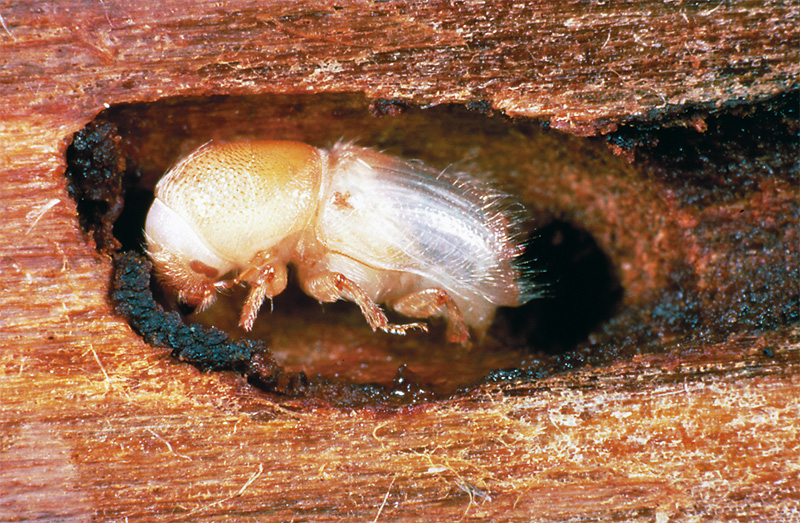The beetle (Ips duplicatus) is native to East Asia, Siberia and Fennoscandia. Over the past few years, it has been spreading to the south and west and has also been found on species of pine and larches in East, Southeast and Central Europe. In addition to natural dispersal, the transport of barked spruce wood is probably also responsible for the beetle's spread.
Significance for forestry
Although the northern bark beetle infests living trees, in neighbouring countries it has so far had less of an impact on forestry than the spruce bark beetle (Ips typographus). The two species also colonise their host trees together, with the northern bark beetle tending to favour the middle and upper stem as well as the crown area, while the spruce bark beetle is more likely to be found in the lower stem area.
The European and Mediterranean Plant Protection Organization (EPPO) currently considers the northern bark beetle to be less aggressive than the widespread, native spruce bark beetle. However, the former could also impact the economy, as demonstrated in 2000 by a Europe-wide survey on the economic impact of forest insect pests. Forest entomologists from Poland and Slovakia have now described the species as economically relevant. Mass outbreaks of this bark beetle species have also been recorded in the Czech Republic in connection with extreme climatic conditions.
Risk of confusion
At first glance, it is difficult to distinguish the northern bark beetle from the widespread spruce bark beetle because the two look very similar. The northern bark beetle is typically slightly smaller (2.8 to 4.5 mm) than the spruce bark beetle (4.2 to 5.5 mm). Both species are dark brown and have four teeth on their elytra. Owing to these similarities, it is only possible to clearly distinguish between the two under a microscope.
The main distinguishing feature is the shape and arrangement of the teeth on the elytra. On the northern bark beetle, the second and third teeth are fused at the base (indicated by the arrow in Fig. 1). The sexes of both species can be distinguished by the shape of the third tooth.
The two species also have very similar breeding galleries. However, those familiar with the exit holes of the spruce bark beetle will notice that the holes created by an infestation of the northern bark beetle are usually much smaller (1 to 1.2 mm in diameter).
The two species are also similar in their development. In Switzerland, there are usually two generations at lower elevations. The spring flight of the northern bark beetle normally takes place a few days earlier than that of the spruce bark beetle. In Central Europe, the bark beetle species is assumed to complete two generations per year. The beetles generally leave their host tree in autumn and overwinter in the ground litter.
Due to the great risk of confusion between the two bark beetle species, it may be that a determination was not always clear in the past. But ultimately, when weakened spruces are attacked, it does not matter by which bark beetle species they are colonised and killed.
Situation in Switzerland
As monitoring by Beat Wermelinger (WSL) has shown, this invasive beetle species first reached Switzerland in 2019. He documented occurrences of the species in the St Gallen Rhine Valley (194 individual insects near Altstätten, 175 near Rüthi as well as five near Gams) and in Liechtenstein (14 in Nendeln and 32 in Schaan). Wermelinger thinks it possible that this species could have already migrated from neighbouring countries several years previously but remained undetected until 2019.
Following Wermelinger's 2019 survey, in 2020 Swiss Forest Protection launched an extended monitoring programme to map the continued spread of the new bark beetle species in Switzerland.
Monitoring in Switzerland
Forest protection officers and the relevant foresters helped choose the sites to be monitored by Swiss Forest Protection at cantonal level. Traps were first placed in a semicircle around the sites where the beetle species has been observed since 2019. The foresters then laid additional traps in a second, wider semicircle. Starting from the first observation sites, further traps were also positioned along the Swiss Plateau into the canton of Fribourg as well as in the Jura with a view to mapping the progress of this invasive species (see Fig. 3).
The traps had to be laid in areas where there were enough spruce trees receiving modest levels of sunlight and lying along transit routes or at the edge of a forest or clearing, and possibly also infested with spruce bark beetle.
The bark beetle traps were laid between early April and late July and were loaded with a pheromone specially developed for the northern bark beetle (Dupliwit, developed by Witasek). The traps were regularly emptied by the respective forest protection officers, forestry agencies or forest districts. The morphological identification of the captured beetles took place in the WSL Plant Protection Laboratory and was confirmed by genetic analyses (barcoding).
2019
Occurrences of this invasive bark beetle species have been recorded in Switzerland since 2019, when it was found at three sites in the St Gallen Rhine Valley and at two trap sites in Liechtenstein. It is possible that the species had already migrated from neighbouring countries several years previously and remained undetected until 2019.
2020
In 2020, Swiss Forest Protection, together with several cantons, launched an extended monitoring programme to map the continued spread of the new bark beetle species in Switzerland. Based on the first recorded observation sites, 18 monitoring sites were chosen across eight cantons in 2020 and nine in 2021.
In 2020, small numbers of the northern bark beetle were detected at two further sites in the canton of St Gallen, namely in Rorschacherberg (two individuals) and St Gallen (one individual).
2021
In 2021, these two sites were replaced by a new site in St Gallen and another in the canton of Thurgau. One northern bark beetle was also found at a trap site in Gams in the canton of St Gallen.
The results for Switzerland to date show that the species is spreading, but apparently very slowly and so far not in large numbers. Based on the beetles trapped in 2020 and 2021, the northern bark beetle is spreading slightly to the north and west of where it was observed in 2019 (see Fig. 3). No beetles were detected at the southern trap sites in either monitoring year, nor have the trap sites further west caught any beetles so far.
2022
Forest Protection Switzerland will continue this monitoring with slightly adapted sites in 2022. The evaluation of the trap walks revealed two new detection points for the Nordic spruce bark beetle: Bettwiesen in the canton of Thurgau (2 specimens) and Rueun in the canton of Graubünden (1 specimen).
2023
In 2023, the presence of Ips duplicatus was once more detected at various sites. These were 3 sites in Thurgau (Frauenfeld, Amriswil, Weinfelden), 2 sites in St. Gallen (Sargans, Kirchberg), 1 site in the canton of Zurich (Winterthur), 2 sites in the canton of Appenzell Ausserrhoden (Waldstatt, Bühler) and 1 site in Graubünden (Zizers).
Outlook 2024
In order to gain greater understanding of how this beetle species spreads, the conditions favourable to its spread, and what its damage potential is likely to be in this country, we will also be setting up traps in 2024 and conducting additional surveys on site.
Countermeasures
The measures used to prevent and combat other bark beetle species would also prove effective in controlling the northern bark beetle, namely removing potential breeding material and the felling and rapid removal or debarking of infested trunks. All in all, the northern bark beetle is more difficult to combat than the spruce bark beetle, because effective felling in winter, a measure used to combat the latter, is not useful here, since the second generation of the northern bark beetle leaves its host trees in autumn and overwinters in the ground litter. Crown infestations are also more difficult to detect in time. Often the crown only dies when the beetles have already left the tree. The introduction of the beetle via barked spruce wood from other infestation areas such as Germany, Austria or the Czech Republic should also be avoided.
Translation: Tessa Feller

